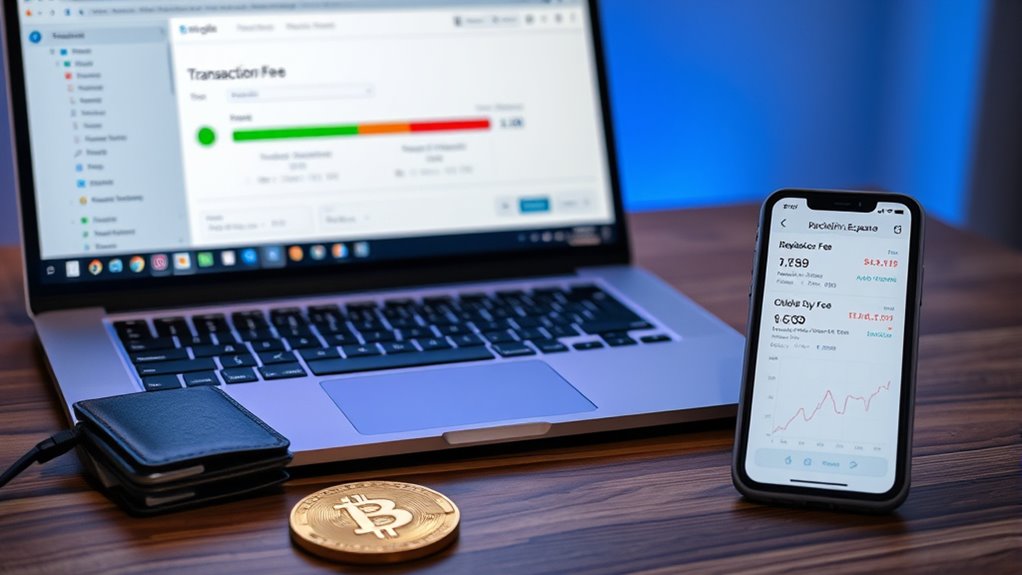If your Bitcoin transaction gets stuck due to low fees or network congestion, you can use Replace-By-Fee (RBF) to resend the same transaction with a higher fee, making it more attractive to miners. If RBF isn’t supported, Child-Pays-For-Parent (CPFP) allows you to create a new transaction spending the unconfirmed output with a higher fee to incentivize confirmation of both. Understanding these methods helps guarantee your transaction confirms smoothly—more details on how to apply them await.
Key Takeaways
- Use Replace-By-Fee (RBF) to resend the transaction with a higher fee if supported by your wallet.
- Create a new transaction spending the unconfirmed output with a higher fee to implement Child-Pays-For-Parent (CPFP).
- Ensure your original transaction is RBF-enabled or supported to effectively bump fees or replace it.
- Confirm your wallet supports fee bumping techniques to avoid transaction malleability issues.
- Monitor network conditions and set appropriate fees initially to prevent transactions from becoming stuck.

If your Bitcoin transaction gets stuck or failed, don’t panic—there are steps you can take to fix it. Often, a transaction remains pending because the fee you included wasn’t high enough for miners to prioritize it. When this happens, understanding fee estimation is essential. Wallets typically suggest a fee based on current network conditions, but sometimes they underestimate, especially during busy times. As a result, your transaction can become “stuck,” waiting indefinitely in mempool. Additionally, transaction malleability can complicate matters; it’s a vulnerability that allows the transaction ID to change before confirmation, making it harder to track and sometimes interfering with certain recovery methods. Recognizing these issues is the first step toward resolving the problem.
One effective way to fix a stuck transaction is to use the Replace-By-Fee (RBF) feature, if your wallet supports it. RBF allows you to resend the same transaction with a higher fee, incentivizing miners to include it more quickly. To do this, you need to create a new transaction that spends the same inputs but with a larger fee. Your wallet will usually have an option to “replace” or “bump” the fee for pending transactions. This method is straightforward, but it only works if your initial transaction was flagged as RBF-enabled. If not, you might need to consider other strategies, like using a child-pays-for-parent (CPFP) approach.
Child-pays-for-parent involves creating a new transaction that spends the unconfirmed output of your initial transaction, attaching a considerably higher fee. Miners, motivated by the higher fee, will process both the parent and child transactions together, confirming them faster. This approach is especially useful when RBF isn’t an option, or if your initial transaction was non-RBF. Be aware, though, that this requires a compatible wallet and some understanding of how unconfirmed transactions work. Additionally, understanding network congestion and fee dynamics can help prevent these issues from occurring in the first place.
Transaction malleability, once a common obstacle, can sometimes interfere with these methods because it alters transaction IDs, complicating the process of replacing or referencing the original transaction. Modern wallets and network upgrades have reduced malleability issues, but it’s still wise to be cautious. Always verify whether your wallet supports fee bumping techniques and check the current network conditions to avoid underestimating the necessary fee. Proper fee estimation helps guarantee your transaction confirms promptly, preventing the need for these fixes altogether. When in doubt, consult your wallet’s documentation or support to choose the best strategy for your situation.
Frequently Asked Questions
How Long Does It Typically Take to Replace a Stuck Transaction?
When replacing a stuck Bitcoin transaction, the confirmation time depends on your fee estimation and network congestion. Usually, it takes a few minutes to a few hours for miners to process the new transaction, but this varies. If you set a higher fee using RBF, you can speed up confirmation time. Keep an eye on the mempool status and adjust your fee accordingly to guarantee quicker confirmation.
Can RBF Be Used to Increase Transaction Privacy?
You might wonder if RBF can boost your transaction privacy. While RBF primarily allows you to increase fees and replace a transaction, it can also serve as a privacy enhancement by enabling transaction obfuscation. By replacing transactions with different fee structures or addresses, you make it harder for outsiders to trace your activity. However, RBF isn’t designed specifically for privacy, so consider combining it with other tools for better transaction obfuscation.
Are There Risks Associated With Using Child-Pays-For-Parent?
Think of child-pays-for-parent as a double-edged sword. While it helps you accelerate stuck transactions, it also risks complicating your transaction history, making it more vulnerable to transaction malleability. If fee estimation isn’t precise, you might overpay or face delays. Use it carefully to avoid unexpected fees or confusion, and always double-check your transaction details before proceeding to keep your Bitcoin safe and transparent.
What Fees Should I Set for RBF to Ensure Prompt Confirmation?
When setting RBF fees, you should consider fee estimation tools to guarantee prompt confirmation. To speed up confirmation, increase your fee above the current average, typically by 10-20%. This adjustment helps miners prioritize your transaction. Keep in mind, the higher the fee, the faster your transaction confirms. Always monitor network conditions and use reliable fee estimation tools to balance cost and confirmation speed effectively.
Is It Possible to Recover a Transaction if RBF Fails?
Think of your transaction as a ship steering through rough seas. If RBF fails, recovery isn’t guaranteed, but you can try fee management strategies like Child-Pays-For-Parent to reroute it. While RBF helps speed confirmation, it’s not foolproof for recovery. To improve your chances, monitor network conditions and consider bumping fees early. Remember, proactive fee adjustments are your best bet to avoid getting stranded in the transaction storm.
Conclusion
Now that you know how to fix a stuck Bitcoin transaction using replace-by-fee and child-pays-for-parent, you’re better equipped to navigate network congestion. Think of it like sending a telegram during a busy night at the telegraph office—you just need the right tools to get your message through. With patience and the right approach, your transaction will soon be confirmed, just like a letter finally arriving after waiting by the mailbox in your vintage postal box.









